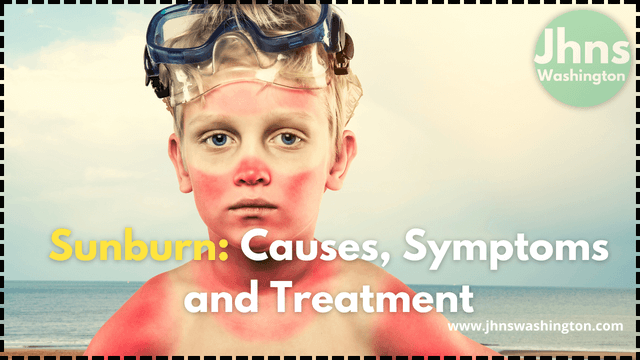Sunburn: Causes, Symptoms, and Treatment

Sunburn occurs when the skin is damaged by ultraviolet radiation. The mechanism of its development is somewhat different from the thermal burn. In some cases, not only the skin but also the organs of vision suffer.
For owners of fair skin type, a similar manifestation may occur after 20-30 minutes of exposure to the sun.
A person with darker skin is less susceptible to epidermal damage in similar conditions.
But exposure to direct sunlight and not following the safety measures of being outdoors in hot weather negatively affects any type of skin.
During exposure to the sun, melanin is produced in the human body. Its amount is genetically determined.
For some, outdoor recreation on a hot day will turn into a tan, and for someone a burn.
For people who have low melanin levels, going to the beach, swimming in bodies of water without skin protection, and visiting a tanning bed can lead to painful manifestations.
Factors that increase the risk of sunburn
Certain factors can increase the risk of sunburn, including:
- Genetic predisposition.
- Staying outdoors for a long time during the hot season.
- Swimming in water bodies increases the risk of getting burnt. Water droplets on the body act as a lens. The surface of the water reflects sunlight.
- Drinking alcohol during outdoor recreation, and exposure to sunlight.
- Taking some medications increases the sensitivity of the skin to ultraviolet rays. For example, antibiotics and diuretics can cause a similar reaction.
It is a mistake to think that you can get a sunburn only in clear weather. UV rays can damage the skin even on a cloudy day.
Signs and degrees of sunburn
Depending on the clinical picture, there are two main degrees of sunburn.
Often, characteristic signs appear after half an hour of exposure to the sun, sometimes during the first day.
The severity of the symptoms affects the treatment tactics. In some cases, home observation is sufficient, and in some additional medical care will be required.
What are the types of sunburn?
First degree
In the case of first-degree sunburn, the top layer of the skin, the epidermis, is affected.
- Hyperemia of body parts that were not protected from exposure to sunlight.
- Local hyperthermia appears. The affected skin is warm to the touch. An increase in overall body temperature is also possible.
- There is a feeling of tightness and a feeling of dryness of the skin.
- Puffiness appears at the site of the burn.
- Probably the manifestation of symptoms such as general fatigue, weakness, and malaise.
- Headache.
- Nausea.
- The appearance of vesicles - blisters of small diameter, filled with liquid.
- A few days after receiving a sunburn, peeling of the upper layer of the skin may appear.
With the right approach in first aid, the effects of sunburn will pass painlessly, leaving no noticeable marks on the skin. Full recovery will take at least one to two weeks.
Second degree
Second-degree sunburn is characterized by damage not only to the outer layer of the skin but also to deeper tissues. The dermal layer of the skin suffers, the recovery of which will take more time.
- Pronounced hyperemia of the affected area of the body.
- Acute pain syndrome at rest and during palpation.
- Increase in body temperature.
- Edema.
- The formation of blisters of a larger diameter than in the first degree, on a large area of the skin.
A second-degree burn will take several weeks to heal. If there is no improvement in the condition, you should immediately seek medical help.
In the event of complications, the addition of a bacterial infection, and significant damage to the body area, treatment in a hospital may be required.
Heatstroke
You should seek emergency medical attention if you or your loved ones show signs of heat stroke.
- Increase in body temperature.
- Feeling chills.
- Headache.
- Darkening in the eyes, dizziness.
- Nausea, vomiting.
- Muscle spasms, convulsions .
- Confusion of consciousness, slurred speech.
- Rapid breathing and pulse.
Symptoms of sunburn and heat stroke can occur at the same time. This kind of burn occurs as a result of exposure to ultraviolet rays. Heat stroke occurs due to the high temperature of the external environment.
First aid for sunburn
In the vast majority of cases, burns are treated at home on their own. In the case of timely first aid and the right treatment tactics, the skin will quickly recover.
After the regeneration stage, there will be no traces of burns. Therefore, the first measures to provide assistance should be taken immediately.
Assess your condition. Call an ambulance if you feel nausea, severe headache, or dizziness. Perhaps these are signs of heat stroke.
If the general condition of the body is satisfactory, attention should be paid to the skin for its speedy recovery.
- It is necessary to leave a sunny place and find a cooler one. The shade of trees, a canopy, and a room will do.
- Take a cool shower. This measure will cool the skin overheated in the sun. Do not use soap, gel, or other bath products. The substances contained in them can adversely affect the damaged epidermis. After dousing with water, do not rub the skin with a towel, but simply blot it so as not to further injure it mechanically.
- To relieve pain, you can take a non-steroidal anti-inflammatory drug. In this case, you should consult with a healthcare professional. If you are on the beach, contact the medical center in the recreation area.
- You should also consult your doctor about products that can be applied to the skin in case of sunburn. It is important to prevent the attachment of a bacterial infection, especially in the case of blisters on the skin.
- You will need to drink plenty of water. The water should not be hot, but not too cold either. Mineral water or ordinary drinking water is suitable. This way you will prevent dehydration.
- Take an antihistamine, this will relieve a slight swelling of the tissues.
- Wear clothing that will protect the affected skin throughout the recovery period. Give preference to a loose fit. Clothing that is tight to the body can interfere with tissue regeneration.
What not to do with sunburn
In order to reduce the risk of complications, you should follow simple recommendations.
- No need to lubricate the skin damaged by ultraviolet radiation with ice cubes. This manipulation can aggravate the situation and delay the recovery period. There is a possibility of noticeable defects on the skin - burn marks.
- While bathing in the shower, you can not use a washcloth, so as not to scratch the already damaged skin. It is also worth refusing to use a body scrub.
- Avoid contact with damaged skin substances containing alcohol. This promotes dehydration and can cause a chemical burn.
- Do not apply fatty oils, or creams to the skin during the healing period. These products create a film on the surface of the body, preventing the respiratory function of the skin.
- Puncturing blisters can lead to the addition of a bacterial infection. You cannot open them yourself.
- Abuse of alcoholic beverages, coffee, and tea contributes to dehydration.
- Sunbathing is not recommended during the healing period of the skin. Avoid sun exposure until the skin is fully restored.
- Do not remove skin that is flaky. This can damage the healthy layer of the skin.
Prevention of sunburn
- Use sunscreen with SPF 30 or higher. If you plan to swim in the sea, use a waterproof type of sunscreen.
- A wide-brimmed hat will help protect your head, neck, and face from sun exposure.
- Stay in the shade, especially during hot hours.
- Wear sunglasses. They will help protect the eyes from the effects of ultraviolet radiation, which is unsafe for the organs of vision. Sunburn of the eyes is accompanied by "snow blindness". Eyes reddened, inflamed, watery, itchy. Vision becomes blurred, and there is an increase in sensitivity to light.
